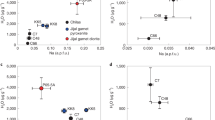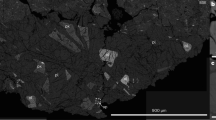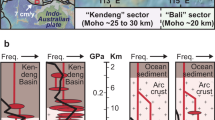Abstract
ISOTOPE ratios and concentrations of incompatible trace elements are remarkably successful in discriminating the tectonic origin and magmatic source components for basalts1–5. But problems remain with discriminating the tectonic origin of some tholeiites, especially where field relations and other geological evidence are ambiguous. For example, the tectonic origin of basalts from the Troodos ophiolite (Cyprus) has been debated for several decades. Most workers have been unable to distinguish between an island-arc and/or back-arc origin for the ophiolite6–8. Here we use volatile, K2O and TiO2 contents from ∼250 fresh submarine volcanic glasses to discriminate between tholeiites from different tectonic regimes. K2O÷H2O ratios are lower (<0.70) in spread ing-centre glasses than in those from island arcs and intraplate oceanic islands. Back-arc-basin basalts can generally be separated from mid-ocean-ridge basalts by their high H2O contents. Using this information, we show that some fresh glasses from the Troodos ophiolite have a clear back-arc-basin affinity.
This is a preview of subscription content, access via your institution
Access options
Subscribe to this journal
Receive 51 print issues and online access
$199.00 per year
only $3.90 per issue
Buy this article
- Purchase on Springer Link
- Instant access to full article PDF
Prices may be subject to local taxes which are calculated during checkout
Similar content being viewed by others
References
Perfit, M. R., Gust, O. A., Bence, A. E., Arculus, R. J. & Taylor, S. R. Chem. Geol. 30, 227–256 (1980).
White, W. M. & Patchett, J. Earth planet. Sci. Lett. 67, 167–185 (1984).
Ellam, R. M. & Hawkesworth, C. J. Contrib. Miner. Petrol. 98, 72–80 (1988).
Pearce, J. A. & Norry, M. J. Contrib. Miner. Petrol. 69, 33–47 (1979).
Pearce, J. A. in Andesites (ed. Thorpe, R. S.) 525–548 (Wiley, New York, 1982).
Rautenschlein, M. et al. Earth planet. Sci. Lett. 75, 369–383 (1985).
Thy, P., Brooks, C. K. & Walsh, J. N. Lithos 18, 165–178 (1985).
Moores, E. M., Robinson, P. T., Malpas, J. Xenophonotos, C. Geology 12, 500–503 (1984).
Muenow, D. W., Graham, D. G., Liu, N. W. K. & Delaney, J. R. Earth planet. Sci. Lett. 42, 71–76 (1979).
Byers, C. D, Garcia, M. O. & Muenow, D. W. Geochim. cosmochim. Acta 49, 1887–1896 (1985).
Garcia, M. O., Muenow, D. W. & Aggrey, K. E. J. geophys. Res. 94, 10525–10538 (1989).
Garcia, M. O., Liu, N. W. K. & Muenow, D. W. Geochim. cosmochim. Acta 43, 305–312 (1979).
Delaney, J. R., Muenow, D. W. & Graham, D. G. Geochim. cosmochim. Acta 42, 581–594 (1975).
Byers, C. D., Garcia, M. O. & Muenow, D. W. Earth planet. Sci. Lett. 79, 9–20 (1986).
Byers, C. D., Muenow, D. W. & Garcia, M. O. Geochim. cosmochim. Acta 47, 1551–1558 (1983).
Byers, C. D., Christie, D. M., Muenow, D. W. & Sinton, J. M. Geochim. cosmochim. Acta 48, 2239–2245 (1984).
Muenow, D. W., Liu, N. W. K., Garcia, M. O. & Saunders, A. D. Earth planet. Sci. Lett. 47, 272–278 (1980).
Aggrey, K. E., Muenow, D. W. & Sinton, J. M. Geochim. cosmochim. Acta 52, 2501–2506 (1988).
Aggrey, K. E. thesis, Univ. Hawaii (1989).
Graham, D. G., Muenow, D. W. & Gibson, E. K. Jr Proc. 10th Lunar planet. Sci. Conf. 1617–1627 (1979).
Exley, R. A., Mattey, D. P., Clague, D. A. & Pillinger, C. T. Earth planet. Sci. Lett. 78, 189–199 (1986).
Craig, H. Earth planet. Sci. Lett. 82, 384–386 (1987).
Sinton, J. M. & Fryer, P. J. geophys. Res. 92, 12782–12802 (1987).
Moores, E. M. & Vine, F. J. Phil. Trans. R. Soc. A268, 443–446 (1971).
Miyashiro, A. Earth planet. Sci. Lett. 19, 218–224 (1973).
Flower, M. F. J. & Levine, H. M. Contrib. Miner. petrol. 97, 509–524 (1987).
Bednarz, U. thesis, Ruhr-Universität (Bochum) (1988).
Bednarz, U., Sunkel, G. & Schmincke, H. U. Geol. Surv. Can. 85, 183–204 (1987).
Author information
Authors and Affiliations
Rights and permissions
About this article
Cite this article
Muenow, D., Garciat, M., Aggrey, K. et al. Volatiles in submarine glasses as a discriminant of tectonic origin: application to the Troodos ophiolite. Nature 343, 159–161 (1990). https://doi.org/10.1038/343159a0
Received:
Accepted:
Issue Date:
DOI: https://doi.org/10.1038/343159a0
This article is cited by
-
Quenching of basaltic melts by volatile exsolution
Contributions to Mineralogy and Petrology (2023)
-
Mineral-scale variation in the trace metal and sulfur isotope composition of pyrite: implications for metal and sulfur sources in mafic VMS deposits
Mineralium Deposita (2022)
-
Constraints on the formation of geochemically variable plagiogranite intrusions in the Troodos Ophiolite, Cyprus
Contributions to Mineralogy and Petrology (2014)
-
Water in boninite glass and coexisting orthopyroxene: concentration and partitioning
Contributions to Mineralogy and Petrology (1995)
-
Mafic magma batches at Vesuvius: a glass inclusion approach to the modalities of feeding stratovolcanoes
Contributions to Mineralogy and Petrology (1995)
Comments
By submitting a comment you agree to abide by our Terms and Community Guidelines. If you find something abusive or that does not comply with our terms or guidelines please flag it as inappropriate.



